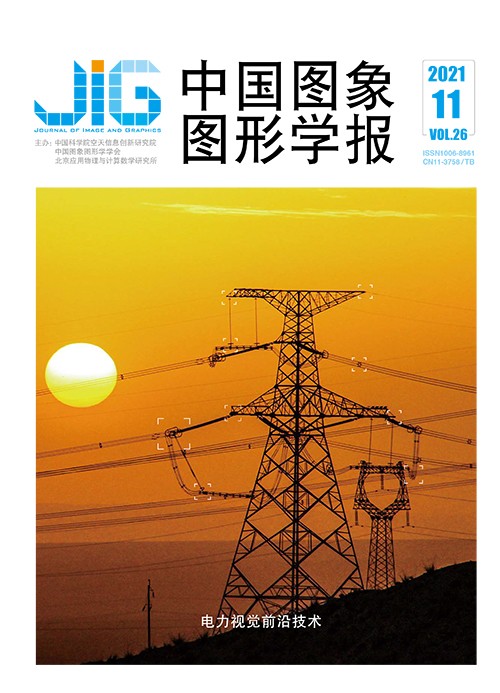
最优知识传递宽残差网络输电线路螺栓缺陷图像分类
戚银城1,2, 金超熊1, 赵振兵1,2, 丁洁涛1, 吕斌3(1.华北电力大学电气与电子工程学院, 保定 071003;2.华北电力大学河北省电力物联网技术重点实验室, 保定 071003;3.国网浙江杭州萧山区供电有限公司, 杭州 310000) 摘 要
目的 输电线路螺栓图像具有分辨率低和视觉信息较差的特点,针对螺栓缺陷图像分类时教师网络(大模型)参数量大、学生网络(小模型)分类精度低的问题,提出了一种最优知识传递宽残差网络输电线路螺栓缺陷图像分类方法,来弥补使用大小模型进行分类任务的局限性。方法 首先改变大模型宽度,即拓宽网络特征表达维度来增加向小模型传递的螺栓缺陷知识和简化小模型结构至3个残差块;然后为了选出传递螺栓缺陷知识性能最优的大模型,提出知识偏差的概念来可视化大模型向小模型螺栓缺陷知识传递的程度,综合分析不同宽度大模型利用知识蒸馏算法与注意力转移算法分别指导小模型训练后的分类准确率,并用知识偏差来确定最优知识传递模型;最后将最优知识传递模型利用知识蒸馏算法与注意力转移算法相结合指导小模型训练,尽可能提升小模型的螺栓缺陷分类性能。结果 在自建螺栓缺陷图像分类数据集上进行了验证,结果表明宽度为5的大模型向小模型传递螺栓缺陷知识性能最优,使小模型的螺栓缺陷分类准确率提高了5.56%,小模型与最优大模型的分类准确率只差2.17%,知识偏差为0.28,且小模型的参数量仅为大模型参数量的0.56%。结论 本文提出的最优知识传递宽残差网络输电线路螺栓缺陷图像分类方法,弥补了大小模型螺栓缺陷图像分类的局限性,实现了精度与资源消耗的平衡。
关键词
Image classification method of transmission line bolt defects using the optimal knowledge transfer wide residual network
Qi Yincheng1,2, Jin Chaoxiong1, Zhao Zhenbing1,2, Ding Jietao1, Lyu Bin3(1.School of Electrical and Electronic Engineering, North China Electric Power University, Baoding 071003, China;2.Hebei Key Laboratory of Power Internet of Things Technology, North China Electric Power University, Baoding 071003, China;3.State Grid Zhejiang Hangzhou Xiaoshan Power Supply CO., LTD., Hangzhou 310000, China) Abstract
Objective Bolts play a key role in fixing and connecting various metal parts in transmission lines. Defects seriously affect the power transmission of transmission lines. The imaging background of an inspection image is complicated, the imaging distance and angle are variable, and the bolts occupy a small proportion in the inspection image. Thus, bolt defect images of transmission lines have low resolution and scarce visual information, and they usually require a large model with high complexity and excellent performance to classify bolt defects and ensure accuracy. A large model has a complex structure and numerous parameters, and deploying it on a large scale is difficult due to a large amount of computing resources needed in data analysis. A small model has a simple structure and few parameters, but it cannot completely guarantee the accuracy of bolt defect classification. This study proposes an image classification method of transmission line bolt defects based on the optimal knowledge transfer network to compensate for the limitations of bolt defect classification using large and small models. Method The width of the large model is changed, that is, the dimension of network feature expression is broadened, to fully mine the target information in the bolt image, thereby increasing the bolt defect knowledge of the transferability of the large model to the small model. To reduce the parameters of the small model considerably and improve its operation and maintenance capabilities, the structure of the small model is simplified to a 10-layer residual network with three residual blocks. The number of convolution kernels of each residual block is 16,32, and 64. Therefore, the small model still has obvious features that focus on the low gradient of the bolt image in the low layer, the high difference area in the middle layer, and the overall characteristics of the bolt image in the high layer. Then, the large models of different widths use the attention transfer algorithm and the knowledge distillation algorithm to guide the training of the small models, and the accuracy of the small models under different widths after the training is calculated. Afterward, the concept of knowledge deviation is proposed to measure the degree of bolt defect knowledge transfer of large models and select the large model with the best performance in transferring bolt defect knowledge. The performance of the large and small models is mapped on a number line in the form of accuracy. The calculation process of knowledge deviation proceeds as follows. First, the difference in bolt defect classification accuracy between the large model with a known width and the small model being instructed is calculated. Second, the difference in bolt defect classification accuracy between the large model and the small model that is not being instructed is computed. Lastly, the ratio of the two differences before and after the calculation is adopted as the knowledge deviation. The smaller the knowledge deviation is, the greater the degree of bolt defect knowledge transfer is from the large model to the small model. The optimal knowledge transfer model is determined according to the knowledge deviation of different widths and the bolt defect classification accuracy of the small models under different guidance methods. The optimal knowledge transfer model combines the attention algorithm and the knowledge distillation algorithm to guide in small model training and maximize the bolt defect classification performance of the small model. Result The self-built bolt defect image classification data set verifies the effectiveness of this method in improving the accuracy of bolt classification of the simplified small model. The data set is constructed by clipping and optimizing the transmission line inspection image. The bolt defect image classification data set contains a total of 6 420 images, including 3 136 normal bolts, 2 820 bolts with missing pins, and 464 bolts with missing nuts, which belong to three categories. Experimental results show that the large model with a width of 5 has the best performance in transferring bolt defect knowledge to the small model, and it increases the bolt defect classification accuracy of the small model by 5.56%. The difference in the accuracy of bolt defect classification between the small model and the optimal knowledge transfer model is only 2.17%. The knowledge deviation is 0.28, and the parameter of the small model is only 0.56% of the parameter of the large model. Conclusion The proposed bolt defect classification method based on the optimal knowledge transfer network greatly alleviates the problems of large model parameters and low classification accuracy of small models caused by bolt image characteristics. Balance is achieved between the classification accuracy of the bolt defect image and resource consumption. The method meets the requirements of actual field operation and maintenance, such as the work requirements of embedded equipment (e.g., online monitoring in transmission lines) and reduces the resource consumption of transmission line patrol data analysis.
Keywords
bolt defect classification optimal knowledge transfer knowledge deviation knowledge distillation attention transfer
|



 中国图象图形学报 │ 京ICP备05080539号-4 │ 本系统由
中国图象图形学报 │ 京ICP备05080539号-4 │ 本系统由